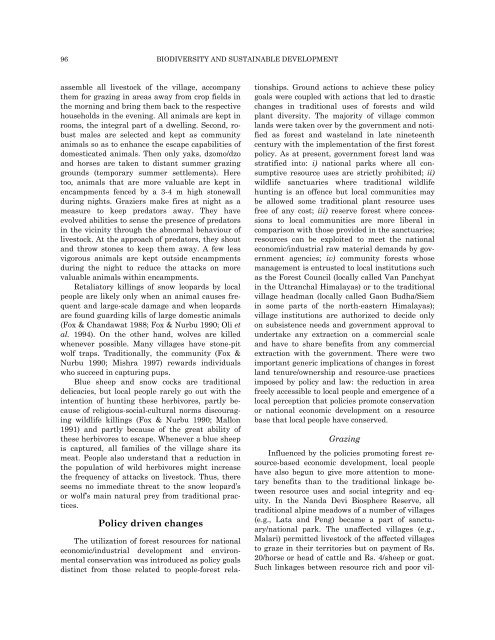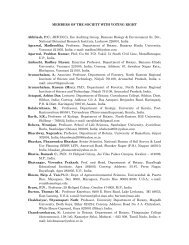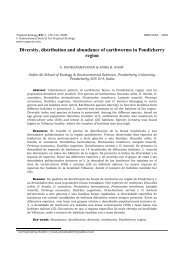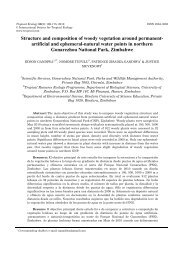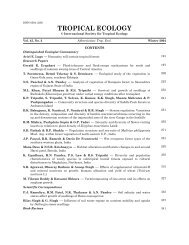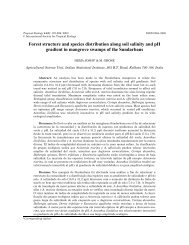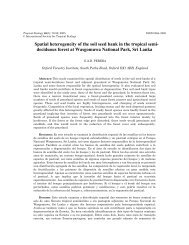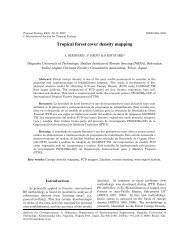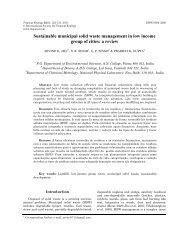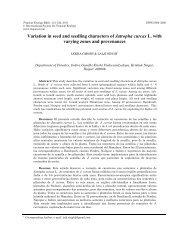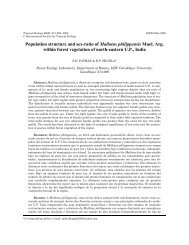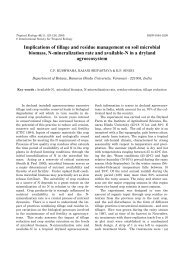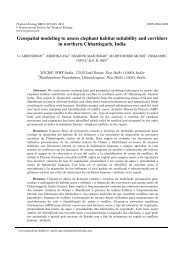Indigenous ecological knowledge, biodiversity and sustainable ...
Indigenous ecological knowledge, biodiversity and sustainable ...
Indigenous ecological knowledge, biodiversity and sustainable ...
Create successful ePaper yourself
Turn your PDF publications into a flip-book with our unique Google optimized e-Paper software.
96 BIODIVERSITY AND SUSTAINABLE DEVELOPMENTassemble all livestock of the village, accompanythem for grazing in areas away from crop fields inthe morning <strong>and</strong> bring them back to the respectivehouseholds in the evening. All animals are kept inrooms, the integral part of a dwelling. Second, robustmales are selected <strong>and</strong> kept as communityanimals so as to enhance the escape capabilities ofdomesticated animals. Then only yaks, dzomo/dzo<strong>and</strong> horses are taken to distant summer grazinggrounds (temporary summer settlements). Heretoo, animals that are more valuable are kept inencampments fenced by a 3-4 m high stonewallduring nights. Graziers make fires at night as ameasure to keep predators away. They haveevolved abilities to sense the presence of predatorsin the vicinity through the abnormal behaviour oflivestock. At the approach of predators, they shout<strong>and</strong> throw stones to keep them away. A few lessvigorous animals are kept outside encampmentsduring the night to reduce the attacks on morevaluable animals within encampments.Retaliatory killings of snow leopards by localpeople are likely only when an animal causes frequent<strong>and</strong> large-scale damage <strong>and</strong> when leopardsare found guarding kills of large domestic animals(Fox & Ch<strong>and</strong>awat 1988; Fox & Nurbu 1990; Oli etal. 1994). On the other h<strong>and</strong>, wolves are killedwhenever possible. Many villages have stone-pitwolf traps. Traditionally, the community (Fox &Nurbu 1990; Mishra 1997) rewards individualswho succeed in capturing pups.Blue sheep <strong>and</strong> snow cocks are traditionaldelicacies, but local people rarely go out with theintention of hunting these herbivores, partly becauseof religious-social-cultural norms discouragingwildlife killings (Fox & Nurbu 1990; Mallon1991) <strong>and</strong> partly because of the great ability ofthese herbivores to escape. Whenever a blue sheepis captured, all families of the village share itsmeat. People also underst<strong>and</strong> that a reduction inthe population of wild herbivores might increasethe frequency of attacks on livestock. Thus, thereseems no immediate threat to the snow leopard’sor wolf’s main natural prey from traditional practices.Policy driven changesThe utilization of forest resources for nationaleconomic/industrial development <strong>and</strong> environmentalconservation was introduced as policy goalsdistinct from those related to people-forest relationships.Ground actions to achieve these policygoals were coupled with actions that led to drasticchanges in traditional uses of forests <strong>and</strong> wildplant diversity. The majority of village commonl<strong>and</strong>s were taken over by the government <strong>and</strong> notifiedas forest <strong>and</strong> wastel<strong>and</strong> in late nineteenthcentury with the implementation of the first forestpolicy. As at present, government forest l<strong>and</strong> wasstratified into: i) national parks where all consumptiveresource uses are strictly prohibited; ii)wildlife sanctuaries where traditional wildlifehunting is an offence but local communities maybe allowed some traditional plant resource usesfree of any cost; iii) reserve forest where concessionsto local communities are more liberal incomparison with those provided in the sanctuaries;resources can be exploited to meet the nationaleconomic/industrial raw material dem<strong>and</strong>s by governmentagencies; iv) community forests whosemanagement is entrusted to local institutions suchas the Forest Council (locally called Van Panchyatin the Uttranchal Himalayas) or to the traditionalvillage headman (locally called Gaon Budha/Siemin some parts of the north-eastern Himalayas);village institutions are authorized to decide onlyon subsistence needs <strong>and</strong> government approval toundertake any extraction on a commercial scale<strong>and</strong> have to share benefits from any commercialextraction with the government. There were twoimportant generic implications of changes in forestl<strong>and</strong> tenure/ownership <strong>and</strong> resource-use practicesimposed by policy <strong>and</strong> law: the reduction in areafreely accessible to local people <strong>and</strong> emergence of alocal perception that policies promote conservationor national economic development on a resourcebase that local people have conserved.GrazingInfluenced by the policies promoting forest resource-basedeconomic development, local peoplehave also begun to give more attention to monetarybenefits than to the traditional linkage betweenresource uses <strong>and</strong> social integrity <strong>and</strong> equity.In the N<strong>and</strong>a Devi Biosphere Reserve, alltraditional alpine meadows of a number of villages(e.g., Lata <strong>and</strong> Peng) became a part of sanctuary/nationalpark. The unaffected villages (e.g.,Malari) permitted livestock of the affected villagesto graze in their territories but on payment of Rs.20/horse or head of cattle <strong>and</strong> Rs. 4/sheep or goat.Such linkages between resource rich <strong>and</strong> poor vil-


